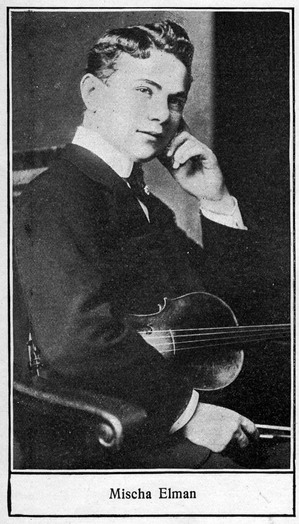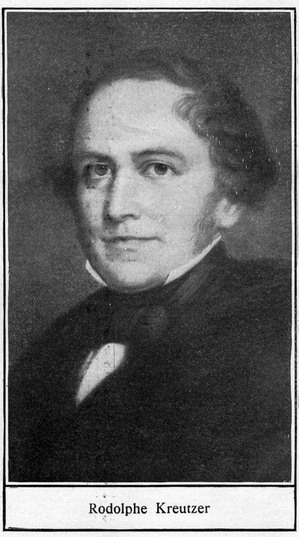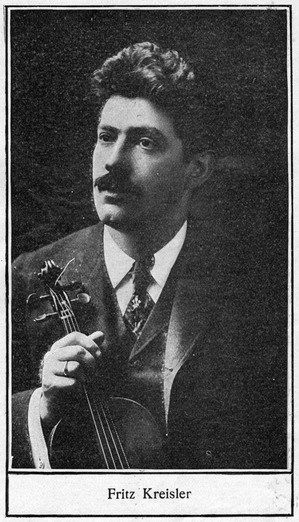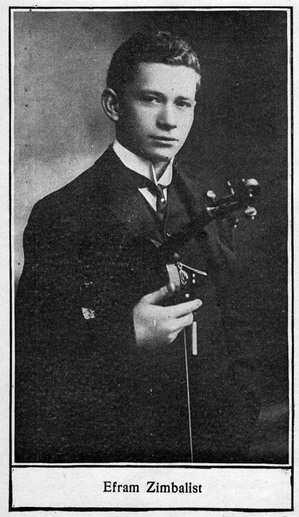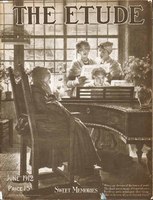Elman was born at Talnoi, Russia, January 21, 1891. He studied at the Royal Music School in Odessa under Fiedelman, first appearing in public in 1899. Professor Leopold Auer was a member of the audience, and at his suggestion Elman went eventually to St. Petersburg in 1901. He came under the personal supervision of Auer and made immediate progress. Elman’s début was made in Berlin, 1934, and his success was immediate, bringing many engagements all over Germany. The following year he appeared in London, and the success he had already achieved in Germany was repeated in England. His first tour of America took place in 1908, and American audiences at once endorsed the opinions of Europe. Few musicians have achieved so fine a reputation at such an early age, and there appears to be little doubt that Elman’s future career will be as successful as that of his prodigy days. At first his style of playing naturally showed the influence of his brilliant teacher, but latterly he has developed a style of his own which marks him out as an artist of great individual attainments. His repertory includes all the great violin concertos and solos. The violin which Mischa Elman used as a boy was a small Nocolas Amati; latterly, however, he has used a Stradivarius, dated 1727. This instrument is in a fine state of preservation.
Kreutzer was born at Versailles, France, November 16, 1766, and died at Geneva, June 6, 1831. He studied the violin with Stamitz, but owed more to his own natural ability. At the age of sixteen, through the favor of Marie Antoinette, he played first violin in the Chapelle du Roi, and later became a member of the orchestra at the Theatre Italien, where his first opera, Jeanne d’Arc, was produced. During the Revolution he was frequently called upon to compose operas de circonstance, which he did with credit. His friendship with Beethoven dates presumably from his visit to Vienna in 1798, but it was seven years later when Beethoven dedicated to him the famous “Kreutzer” sonata for violin and piano. Kreutzer was professor of violin at the Paris Conservatoire from its foundation in 1795, and after he returned to Paris from Vienna, he and Baillot drew up the famous Methode de Violon. His educational work was of the greatest importance, and the Kreutzer Studies are universally recognized as invaluable. He held distinguished posts both under the First Consul and under Louis XVIII, and became chief conductor at the Academie from 1817 to 1824. A broken arm compelled his retirement in 1825, and his last years were embittered by loss of prestige. His compositions included many operas, and also orchestral music, besides works for his chosen instrument.
Kreisler was born in Vienna, February 2, 1875. He first appeared in public when seven years old. As a rule students are not admitted to the Vienna Conservatory until fourteen, but as a concession to his genius he was admitted when seven. His teachers at Vienna were Hellmesberger and Auber. He also studied at the Paris Conservatory under Massart (violin) and Délibes (theory). He won the greatest distinctions at both conservatories, and after a few years’ further study, visited America with Moritz Rosenthal in 1889. Then for some years he gave up his musical career; he studied medicine in Vienna, art in Paris, and finally passed a stiff army examination and became an officer of Uhlands. On resuming his violin concert career he made his début in Berlin with startling success in 1899. Again he came to America, and won even higher praise here than at home. His London début in 1901 won a further confirmation of the American verdict, and from that time he has advanced steadily in the estimation of all competent musicians. He has rapidly come to be considered as the foremost of the younger violinists, as he not only possesses unlimited technique, but is also a musician in the broadest sense of the word. Many of his arrangements, notably that of Dvorak’s Humoreske, are freely used by violinists, though he has done little original composition.
Zimbalist was born at Rostoff-on-Don in 1893, and commenced to play the violin at the age of seven. After playing in his father’s orchestra, he entered the St. Petersburg Conservatory, where he remained for six years under Leopold Auer, the teacher of Mischa Elman and Kathleen Parlow. At the conclusion of his studies he won a prize of 1200 roubles and a gold medal presented by the Russian Government. On this occasion his diploma was endorsed “Incomparable.” He made his début with the Beethoven Saal in Berlin with the Berlin Philharmonic Orchestra. His success was so great that he was almost immediately given a hearing at the Queen’s Hall in London under Arthur Nikisch, and later with the London Symphony under Dr. Hans Richter. His success was immediate, not only in England and Germany, but also in France and Russia. Zimbalist made his American début in Boston, October 27, 1911, and has not failed to win as much admiration here as elsewhere. There can be little doubt that Zimbalist is destined to be one of the world’s great violinists, as he not only possesses complete technical equipment and sound musicianship, but he also possesses that magnetic quality known as “personality,” which plays so large a part in establishing popular favorites. Wherever he has appeared so far he has won immediate success.
Sevcik was born March 22, 1852, at Horazdowitz, Bohemia. He studied first under his father, and then under Anton Bennewitz at the Conservatory of Prague (1866-70). After graduating he gave concerts in Prague, and eventually made his début in Vienna in 1873. At the beginning of his career he suffered many hardships, but he eventually achieved some success in Russia, which led to his being appointed violin professor at the Imperial Music School in Kiev, 1875. He remained there until 1892, when he accepted an invitation from his old teacher, Anton Bennewitz, who was now principal of the Conservatory, to return to Prague as chief violin professor. Good luck attended him by providing for him a brilliant pupil in the person of Kubelik, but any lingering suspicion that Sevcik owed his success entirely to this circumstance was dispelled by the publication of his remarkable Violin Method for Beginners, and by the success of Kocian, Marie Hall and other pupils hardly less noted than Kubelik. His principal success has been in developing the technique of the violin, which he has systematized far in advance of anything previously attempted. His “semitone system” ensures an early development of correct intonation, and leaves the student free to develop bowing technique. Since 1909 Sevcik has been head of the violin department at the Vienna Conservatory.
David was born at Hamburg, June 19, 1810, and died suddenly while on a mountain excursion near Klosters, July 18, 1873. He studied two years (1823-4) under Spohr and Hauptmann at Cassel, and made his first appearance at the Gewandhaus, Leipzig, with which he afterwards became so closely associated in 1825. He became a member of the Königstadt Theatre in Berlin (1827-8), and first became acquainted with Mendelssohn. He spent a few years in Russia, but when Mendelssohn became conductor of the Gewandhaus concerts in 1836, David was appointed concertmeister, a position he retained until his death. He was also appointed violin professor under Mendelssohn when the Conservatory was founded in 1843. His educational influence was great, the two most famous of his many distinguished pupils being Joachim and Wilhelmj. David composed five concertos and a number of other works for the violin, besides two symphonies and an opera. The Violin School contains much invaluable pedagogic material which was the direct outcome of his experience at Leipzig. David deserves special praise for his work in reviving the works of eminent violin players of the old Italian, French and German schools, and for his excellent editing of most of the great violin classics. In his own playing he combined the piquancy of the modern school with the solid merit of Spohr.


